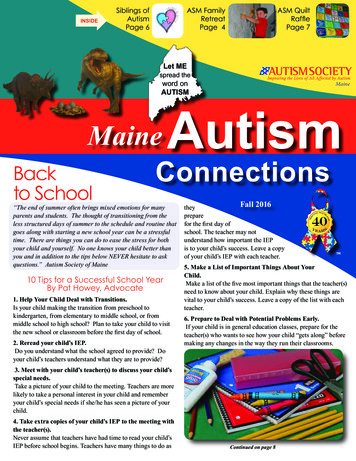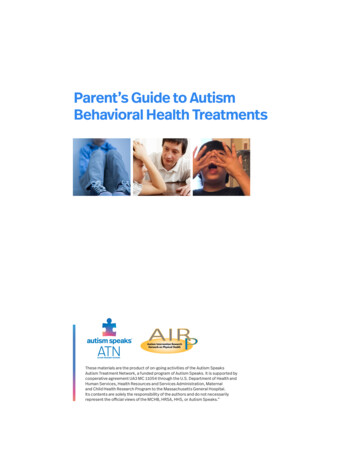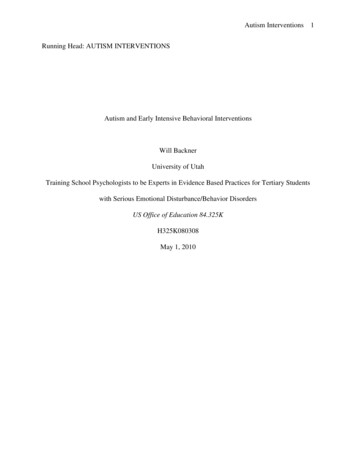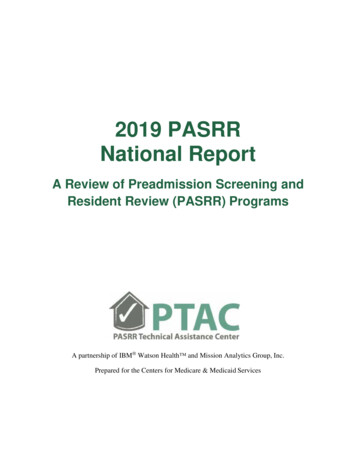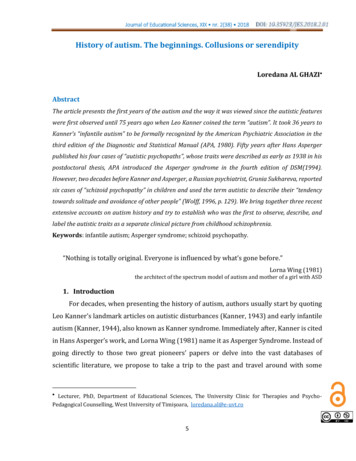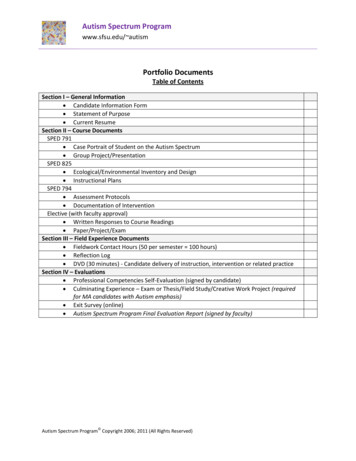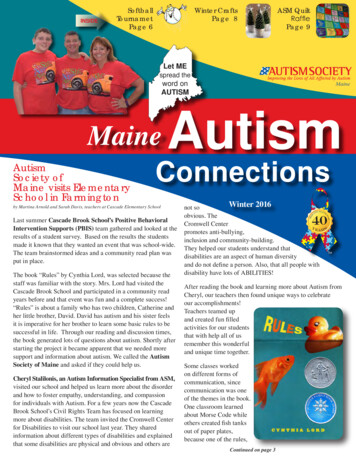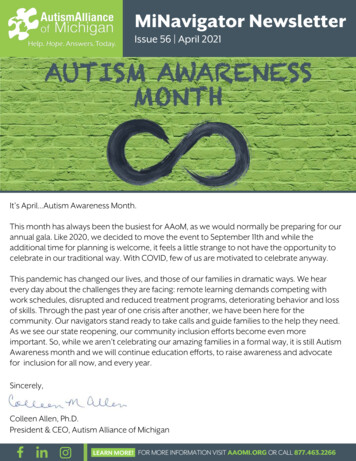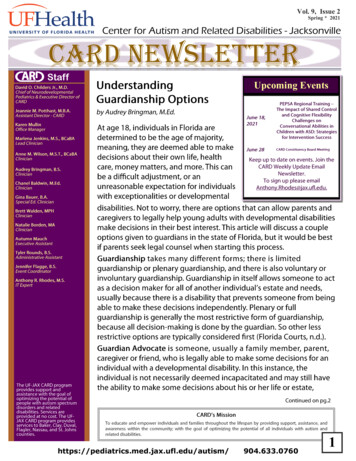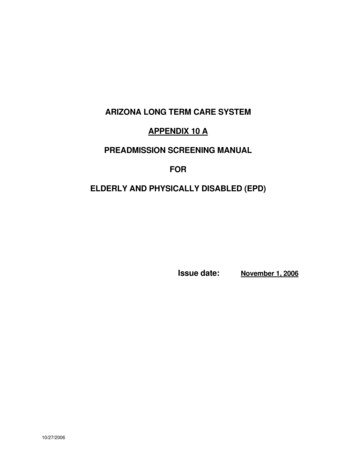
Transcription
ARIZONA LONG TERM CARE SYSTEMAPPENDIX 10 APREADMISSION SCREENING MANUALFORELDERLY AND PHYSICALLY DISABLED (EPD)Issue date:10/27/2006November 1, 2006
THIS PAGE INTENTIONALLY LEFT BLANK
TABLE OF CONTENTSPAGEINTRODUCTION . .1Medicare Part D. 2 & 43I.INTAKE INFORMATION .4A. REFERRAL INFORMATION / PAS INTAKE NOTICE .4Intake/Assessment Information . .5Demographic Information .7B. ASSESSMENT.8Source of Referral . 10Assistance Being Sought .10C. EPD INFORMATION.11D. MEDICAL ASSESSMENT .11II.FUNCTIONAL ASSESSMENT .12A. ACTIVITIES OF DAILY LIVING (ADLs) .12Definitions .13· Mobility .14· Transferring.14· Bathing.15· Dressing.16· Grooming .17· Eating. .17· Toileting.18B. CONTINENCE .19· Bowel Continence .20· Bladder Continence .20C. DETERIORATION IN OVERALL FUNCTION .20i(11/06 EPD)
TABLE OF CONTENTS(Continued)PAGED. COMMUNICATION/SENSORY PATTERNS.20· Hearing .21· Expressive Communication .21· Vision .21E. UNDERLYING CAUSES.22· Physical Impairments.22· Supervision Need/Mental Health .23F.III.ASSISTIVE DEVICES.23EMOTIONAL AND COGNITIVE FUNCTIONING .23A. ORIENTATION.23 Person.24 Place .25 Time .26B. BEHAVIORS .27Definitions .28 Wandering.28 Self Injurious Behavior .29 Aggression .30 Resistiveness.30 Disruptive Behavior.31IV.MEDICAL ASSESSMENT.32A. MEDICAL CONDITIONS .32* ICD-9s (International Classification of Diseases – 9th Revision).33* Major Diagnosis.33* Categories and Related Medical Conditions.331. Hematologic/Oncologic .332. Cardiovascular .333. Musculoskeletal.334. Respiratory .345. Metabolic .34ii(11/06 EPD)
TABLE OF CONTENTS(Continued)PAGE6. Neurological.347. Genitourinary.348. Gastrointestinal .349. Ophthalmologic/EENT.3410. Psychiatric .3411. Skin Conditions .3412. Other Conditions B2.B3.B4.B4.C.Medications .35Insulin .35Medication Assistance.36Therapeutic Diet .36Medication Allergies .36SERVICES AND TREATMENTS .36Need for ications/Monitoring .37Skin Care .38Feedings .39Bladder/Bowel .39Respiratory.39Therapies .40Rehabilitative Nursing .40Other Services and Treatments.41PAS SUMMARY EVALUATION.42Personal Contacts / Source of Information .42Informal Supports.43PAS Summary . 43Medicare Part D.2 & 43E.PAS Eligibility / Scoring .44Special Status.44iii(11/06 EPD)
TABLE OF CONTENTS(Continued)PAGEV. PHYSICIAN REVIEW.44Requested Date 46Requestor Comments . 46Referral.47Eligibility Reviewer’s Summary . .47Review Results / Physician’s Decision .47PAS Override .48VI.POSTHUMOUS PAS AND REASSESSMENTS .48A. Posthumous PAS .48B. Reassessments .49VII.PAS COMPLETION.49ADDITIONAL APPENDICESALTCS OVERVIEW (A1) . A1-1PAS TOOL MATRIX (A2) . A2-1SCORING FLOW CHART (A3) . A3-1 THRU 3GLOSSARY OF TERMS (A4). A5-1 THRU 25GLOSSARY OF ABBREVIATIONS (A5) . A6-1 THRU 6FCPI/CSRD (A6). A7-1 THRU 4iv(11/06 EPD)
INTRODUCTIONLegislationThe Arizona State Legislature passed legislation in 1987 expanding the federally fundedAHCCCS services (Title XIX) to include long term care (LTC). As a result, the ArizonaLong Term Care System (ALTCS) was established with an initial implementation date ofJanuary 1, 1989 for the elderly/physically disabled population (EPD). To receive federalMedicaid funds for an individual, AHCCCS Administration must demonstrate that anALTCS customer has a medical need for these services and is at immediate risk ofinstitutionalization in a nursing facility (NF). For more information on Medicaid seeAHCCCS Eligibility Policy Manual, Chapter 100, Section 101.00.On September 1, 1995, federally funded LTC services were expanded to include theALTCS Transitional Program. This program allows currently eligible ALTCS customerswho have improved and are no longer at immediate risk of institutionalization but stillrequire some LTC services, to receive HCBS services at a lower level of care. For moreinformation on the Transitional Program see AHCCCS Eligibility Policy Manual, Chapter1000, Section 1021.LONG TERM CARE (LTC)Long Term Care refers to ongoing services required by individuals who are in need of carecomparable to that received in a nursing facility (NF). These services represent a widerange of health related services above the level of room and board and offer professionalservices directed towards the maintenance, improvement, or protection of health orlessening of illness, disability or pain. These professional level services include but are notlimited to:1.24 hour licensed nurse supervision;2.All care is under direction of a physician who must make routine visits at intervals of atleast 30 to 90 days or more often;3.Development of a care plan by a multidisciplinary team of professionals (e.g., nursing,social services, registered therapists, registered dietitian) who frequently assessmedical progress.HOME and COMMUNITY BASED SERVICES (HCBS)These long term care services may include home and community based services (HCBS)that offer an alternative to institutional care. ALTCS offers the alternatives in order toensure that the customer in need of institutional level of care may be treated in the leastrestrictive environment.HCBS is appropriate for customers who would requireinstitutionalization, but who can retain a more independent lifestyle with services providedin the home and community setting where the absence of 24 hour licensed nursesupervision will not endanger their health or safety.1(11/06 EPD)10/27/2006
Preadmission Screening (PAS)The EPD PAS tool is used to assess the functional, medical, nursing and social needs ofthe customer. Meeting or exceeding a threshold score on this screening tool establishesinitial eligibility for institutional level services (Arizona Revised Statutes §36-2936). Acombination of weighted functional and medical factors are evaluated and assigned anumerical value to reach totaled scores. The threshold score, or point at which a customerbecomes eligible, is determined by a formula utilizing those scores. The purpose of thefunctional/medical threshold is to ensure that customers deemed eligible for ALTCS requirea Nursing Facility (NF) level of care.The eligible customer needs long term care at a level of care comparable to that providedin a nursing facility, but below an acute care setting (hospitalization or intenserehabilitation) and above a supervisory/personal care setting, intermittent outpatientmedical intervention, or benevolent oversight. A customer, already enrolled with anAHCCCS acute health plan, and who needs less than 90 days of convalescent care maybe ineligible for ALTCS. A customer who does NOT have a non-psychiatric medicalcondition or developmental disability that impacts the need for LTC also may be ineligible.For more information see Section IV Medical Assessment.MEDICARE PART DAs of January 1, 2006, state Medicaid agencies were no longer allowed to pay forprescription medications for individuals eligible for Medicare and Medicaid. Medicareeligible individuals will choose a Medicare drug plan to enroll in to obtain their medications.The financial eligibility specialist, also known as the Program Services Evaluator (PSE) willbe attempting to determine an individual’s eligibility for and enrollment in a Medicare Part Dprescription drug plan. The PAS Assessor may be required to obtain information from theindividual regarding Medicare Part D if at the time of the PAS this information has not beenobtained. The Medicare Part D status must be reported at the beginning of the PASsummary (see page 43). If the customer is already enrolled with a Medicare Part D plan,this information can be found on the RP214.Customer ProfilesIn the aggregate, the eligible ALTCS customer will have a functional and/or medicalcondition that impairs functioning to a degree that interferes substantially with the capacityto remain in the community, and results in long term limitation of capacity for self care. Acustomer who meets ALTCS criteria for Title XIX eligibility will present with a combinationof the following needs or impairments:1.2.3.4.5.6.requires nursing care by or under the supervision of a nurse on a daily basis;requires regular medical monitoring;impaired cognitive functioning;impaired self care with activities of daily living;impaired continence;psychosocial deficits.2(11/06 EPD)10/27/2006
Eligibility ReviewWhen a customer's medical eligibility for Title XIX services is not adequately defined by thescoring criteria, but in the PAS assessor’s professional opinion the customer’s overallcondition is correlated with the needs or impairments as outlined above, the case may bereferred for eligibility review to a consultant physician or an administrative review.It is important to remember that there is no single definition for the level of care for ALTCSmedical eligibility. An entry level of care encompasses a combination of factors. Thesefactors evaluate the differences between individuals in manifestations and severity of agiven disease/condition and the impact on functional ability. An eligible customer shouldhave a combination of factors that impact functional ability and medical need forservices.Population AssessedThe population assessed with the EPD PAS Tool includes the elderly (age 65 and older),the physically disabled (age 6 and over) and also the developmentally disabled residing ina nursing facility. A separate tool is used to assess children under age 6 and persons withdevelopmental disabilities (DD). The PAS tool may also be used to determine whethercustomers not applying would be medically eligible before spending down resources.These customers will be assessed upon request.Assessment TeamThe tool is completed by a registered nurse or a social worker who will use professionaljudgment based on education, experience and ongoing inservice training to describe thecustomer's functional ability and current medical status. If the customer is ventilatordependent, the assessment will be conducted by a registered nurse. If a customer ishospitalized the assessment will be conducted by a registered nurse if at all possible. Athorough assessment will include a personal interview with the customer and caregiver,and a review of pertinent medical records or information as applicable.Client Issue Referral (CIR)When situations are identified that pose immediate and/or serious threat to the customer’swell being (e.g., suicidal threats, environmental hazard, or suspected physical abuse orneglect), appropriate health providers and/or authorities (Adult/Child Protective Services,police, paramedics, guardians) as well as the PAS assessor’s supervisor, should benotified as soon as possible. Documentation of the referral (person notified, date anddescription of the incident) should be entered into the PAS case notes and/or an AHCCCSClient Issue Referral Form completed. For more information on CIR, see the AHCCCSEligibility Policy Manual, Chapter 1000, Section 1018.3(11/06 EPD)10/27/2006
PASRRThe PAS assessor should be aware that all nursing facility (NF) residents and applicantsto Medicaid certified nursing facilities must be assessed through the PreadmissionScreening and Resident Review (PASRR) process. The PASRR is a two-level screeningprocess for mental illness/mental retardation and mandated by the Omnibus BudgetReconciliation Act of 1987 (OBRA '87) as a portion of NF reform measures. The purposeof the PASRR is to avoid inappropriate placement for persons with mental illness and/ormental retardation. For further information regarding PASRR, see the AHCCCS EligibilityPolicy Manual, Chapter 1000, Section 1019.PAS Tool SectionsThe ALTCS Preadmission Screening tool consists of five sections. These sections are:IIIIIIIVVIntake InformationFunctional AssessmentEmotional and Cognitive FunctioningMedical AssessmentPhysician ReviewThis manual provides instructions for completing the PAS tool and guidelines for makingassessment decisions. For more information regarding PAS, see AHCCCS EligibilityPolicy Manual, Chapter 1000.ACEThe information obtained will be entered into the computerized AHCCCS CustomerEligibility (ACE) system, which is the management information system supporting the PAS.FORTISThe medical and financial case documentation obtained is stored by converting paperdocuments into an electronic database called Fortis. All applicable information obtainedwill be scanned into this computerized AHCCCS database using the ACE barcodeseparator sheets.I.INTAKE INFORMATIONA. REFERRAL INFORMATION / PAS INTAKE NOTICEThe PAS Intake Notice is generated by the ACE system at the time the PAS isreferred by the financial eligibility specialist. The PAS Assessor should verifythat the information on the PAS Intake Notice is complete and accurate, andshould notify the financial eligibility specialist of changes or errors.4(11/06 EPD)10/27/2006
The PAS Intake Notice will be comprised of the following fields:CustomerThe customer’s first name, middle initial (if applicable) and last name.Customer NumberThis is the identifying number associated with the customer (also referred to asPerson ID in ACE and Fortis).ALTCS OfficeThis is the Medical Eligibility office assigned to complete the PAS. It will usuallybe the office where the application was taken, but Financial Eligibility may referthe PAS to a different site if they know the client is placed in an area whereanother PAS office has authority.PAS TypeInitial, Reassessment, Posthumous or Private RequestINTAKE/ASSESSMENT INFORMATIONAHCCCS IDThis is the unique identifier for the AHCCCS system. A customer has only oneAHCCCS ID. New customers who have not been AHCCCS members will nothave an AHCCCS ID at this point.AHCCCS MemberThis identifies if an ALTCS customer is already eligible for AHCCCS acuteservices. Usually, these customers are enrolled with an AHCCCS health plan.The application, including PAS, is expedited for health plan members. If an initialALTCS customer is a health plan member who is not expected to need more than90 days of long term care, the individual may not be eligible for ALTCS. Theacute health plan is responsible for up to 90 days of convalescent care. Casesthat might belong in this category should be referred to the physician for eligibilityreview (Please refer to Physician Review on page 46). Any customer that seemsto need less than 90 days of convalescent care should have the AHCCCS healthplan enrollment verified by reviewing mainframe computer screen RP160, RP245or RP285. A name search can be conducted by using the RP290 screen.5(11/06 EPD)10/27/2006
Health Plan NameThis is the name of the Health Plan in which the AHCCCS member is enrolled.Health Plan PhoneThis is the phone number for the Health Plan.Application DateThis is the date the ALTCS application is received in the local office.Referral DateThis is the date the financial eligibility specialist requests a PAS.PAS Due DateThis is the date the PAS is due. This date is six days before the end of theapplication period for the case. The application period is 45 days from theapplication date.DD (Developmental Disability) Status:This is the DD status at the time the PAS is referred.Potential DDDDDD in a Nursing FacilityNot DD (EPD)If there is any question about DD status, this should be investigated andreconciled immediately. FOCUS, DDD’s customer information system shouldalways be checked. Status may also be investigated by conferring with FinancialEligibility and the Department of Economic Security, Division of DevelopmentalDisabilities (DES/DDD). For more information on DD status see Chapter 1000 ofthe AHCCCS Eligibility Policy Manual.DOBDate of Birth6(11/06 EPD)10/27/2006
AgeThis is the customer’s age in years (at the time the referral for PAS is made). Forchildren under 3 years old, the age will be displayed in months. Children under 6years of age will be assessed using the DD tools. It is important to note thechild’s age. If the child is close to changing age groups, the PAS may need to bedelayed to ensure assessment with the proper tool. These cases should bediscussed with a supervisor.SSNThe customer’s Social Security NumberGenderMale or FemaleMarital StatusThe customer’s marital statusLanguageThe customer’s primary languageFinancial Eligibility Specialist NameThe name of the financial worker who requested the PAS, also known as theProgram Services Evaluator (PSE).OfficeThe local office to which the financial eligibility specialist is assigned.UnitThe name of the supervisor or Health Program Manager (HPM) for the work unitwithin the local office where the financial eligibility specialist is assigned.DEMOGRAPHIC INFORMATIONResidence Address (City, State, Zip code)This is the customer’s address at the time of referral. If the applicant is in afacility, the facility address will be the residence address.7(11/06 EPD)10/27/2006
Mailing Address (City, State, Zip Code)The customer’s mailing addressPhoneThis is the customer’s phone number.CountyThis is the county in which the customer currently resides.Authorized RepresentativeA person authorized by the customer, legal representative, or responsible relativeof the customer to act on the customer’s behalf in the AHCCCS eligibility process.Residence Phone NumberThis is the authorized representative’s phone number (if applicable).RelationshipThis is the relationship of the authorized representative to the customer.Business Phone NumberThis is the business phone number of the authorized representative (if applicable).Cell Phone/Pager (Alternate Telephone Number)This is the authorized representative’s cell phone, pager or alternate number (ifapplicable).LocationThis is the location of the customer at the time of the application.Facility NameIf the applicant is in a nursing facility or hospital, the facility name will appear here.PhoneThis is the facility phone number (if applicable).8(11/06 EPD)10/27/2006
Admission DateThe date of admission to the facility (if applicable).Date of DeathThe date of death will be on the PAS Intake Notice if the financial eligibilityspecialist was aware at the time of the referral that the applicant was deceased.If Different From AboveThe PAS Intake Notice has space at the bottom to indicate a change or acorrection to residence address, mailing address, residence county and phonenumber, facility name and phone number, and admission date. Date of deathmay be entered, if applicable. Any changes or corrections to the information onthe Intake Notice should be communicated to the financial eligibility specialist andcan be done by e-mail.B. ASSESSMENTThe Assessment tab of the EPD PAS window in ACE includes the following fields:(these fields are automatically populated by the system).Applicant listThis list includes the customer’s name along with other persons registered in thesame group.AssessorThe PAS assessor who has created the PAS.AssessmentThis list includes the current PAS date and all previous PAS dates.Applicant AgeThis is the customer’s age at the time of the PAS.DD StatusThis field is populated by ACE as a result of the DD Status chosen when theapplication was originally registered.Tool UsedThis field is populated by ACE as a result of the DD Status chosen when theapplication was originally registered and at the time the PAS is created.9(11/06 EPD)10/27/2006
AssessorThis field is automatically populated by the system when the assessor creates thePAS.AssessorThis field is usually blank but if a second assessor assisted with the PAS, thename is selected from the drop down list.Location at time of assessmentThis is the setting where the PAS interview was conducted. The assessor selectsthe appropriate setting from a drop down list in ACE.TelephoneThis is the telephone number at the location where the PAS interview wasconducted. This is a required field and must have a number entered into it beforethe PAS can be completed.Usual Living Arrangement (Select the applicable setting)‘Usual’ refers to the customer’s living arrangement for approximately the last sixmonths or if there is no planned discharge or relocation from the present livingarrangement.Community refers to a customer who lives in a private home, mobile home orapartment.Hospice refers to a medical institution for customers with a terminal illness.Nursing facility may be a certified or uncertified facility.Other supervised setting refers to board and care homes, adult foster homes,adult care homes, supervisory care homes, group homes, apartments for assistedliving, etc.Residential Treatment Center is a facility that provides behavioral healthservices (mental health and substance abuse) to individuals who are under age21, or under age 22 if admitted prior to age 21.Usual Living Situation (Select the usual living situation that applies)Usual living situation refers to with whom the customer has resided forapproximately the last six months. If the customer has been in a living situationfor less than 6 months and there are no plans to make a change, consider that theusual living situation. If a customer resides in a nursing facility or assisted livingsetting where a spouse or other family member also resides, “with non-relatives”should be indicated rather than living with spouse or other relative.10(11/06 EPD)10/27/2006
Source of ReferralRefers to who referred the customer to AHCCCS. Determine if another agency,nursing facility or a case manager recommended or initiated the referral. Entercomments as appropriate. This information is not required on reassessments.Who referred you to AHCCCS? (Select appropriate response)Agency/Case Manager – indicate the name of the agency or personNursing Facility – include the name of the NF and/or case worker’s nameSelf ReferralOther (Specify)Assistance Being Sought Select appropriate response(s). (Indicate the primaryassistance being sought and add others to comments)Indicate the type of assistance the customer and/or family is seeking. More thanone item may apply. Use the comments section to elaborate on wh
AHCCCS services (Title XIX) to include long term care (LTC). As a result, the Arizona Long Term Care System (ALTCS) was established with an initial implementation date of January 1, 1989 for the elderly/physically disabled population (EPD). To receive federal Medicaid funds for an individual, AHCCCS Administration must demonstrate that an
